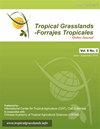Producción animal en pasturas de tres leguminosas asociadas con Urochloa decumbens en los Llanos Orientales de Colombia
IF 0.7
4区 农林科学
Q3 AGRICULTURE, DAIRY & ANIMAL SCIENCE
引用次数: 4
Abstract
In a loamy clay soil of the Colombian Altillanura, animal production of the legumes Centrosema molle accession CIAT 15160, C. macrocarpum accession CIAT 15799 and Grona heterocarpa subsp. ovalifolia (syn. Desmodium ovalifolium) cv. Maquenque, in association with Urochloa decumbens (syn. Brachiaria decumbens) cv. Decumbens, was evaluated under rotational grazing with zebu Brahman steers. The experiment was established in a native savanna area at the Carimagua Research Center of Agrosavia, in a randomized complete block design with three replications. During three years of grazing, C. molle stood out over the other legumes, due to its good forage production and ability to associate and persist with the grass, reaching 40% in the botanical composition in the first year and 24% in the third year. The highest animal liveweight (LW) gains were achieved with this legume with, on average, 760 g/animal/day in the rainy season and 500 g/animal/day in the dry season. With an average stocking rate equivalent to 800 kg LW/ha, mean annual hectare productivity of the pasture with C. molle reached 600 kg LW compared with an average of about 380 kg/ha/year obtained in the other associations and in the grass-only pasture. It is concluded that C. molle CIAT 15160 is a promising pasture legume for the region and confirming its productivity and persistence at farm level and in association with other grasses seems warranted.哥伦比亚东部平原三种与匍匐尾藻相关的豆科牧草的动物生产
在哥伦比亚Altillanura的壤土中,豆科植物centroma molle加入CIAT 15160, C. macrocarpum加入CIAT 15799和Grona heterocarpa subsp.的动物产量。卵形花序(同名:卵形花序)Maquenque,与卧臭尾藻(同:卧臭尾藻)有关。对斑马牛轮牧条件下的背驼进行了评价。实验在Agrosavia Carimagua研究中心的原生稀树草原地区建立,采用随机完全区组设计,有3个重复。在三年的放牧中,由于其良好的牧草产量和与草的关联和持续能力,在其他豆科植物中脱颖而出,第一年达到植物组成的40%,第三年达到24%。该豆类的动物活重(LW)增益最高,在雨季平均为760克/头/天,在旱季平均为500克/头/天。在平均载畜率为800 kg LW/ha的情况下,有毛缕草的牧场的年平均公顷生产力达到600 kg LW,而其他群落和全草牧场的年平均公顷生产力约为380 kg/ha/年。综上所述,C. molle CIAT 15160在该地区是一种很有前途的牧草豆科植物,并且在农场水平上确认其生产力和持久性以及与其他牧草的关联似乎是有必要的。
本文章由计算机程序翻译,如有差异,请以英文原文为准。
求助全文
约1分钟内获得全文
求助全文
来源期刊

Tropical Grasslands-Forrajes Tropicales
Agricultural and Biological Sciences-Agronomy and Crop Science
CiteScore
1.60
自引率
0.00%
发文量
36
审稿时长
16 weeks
期刊介绍:
The Journal publishes, in English or Spanish, Research Papers and Short Communications on research and development, as well as contributions from practitioners (Farmer Contributions) and Review Articles, related to pastures and forages in the tropics and subtropics. There is no regional focus; the information published should be of interest to a wide readership, encomprising researchers, academics, students, technicians, development workers and farmers.
In general, the focus of the Journal is more on sown (''improved'') pastures and forages than on rangeland-specific aspects of natural grasslands, but exceptions are possible (e.g. when a submission is relevant for a particularly broad readership in the pasture and forage science community).
The Journal will also consider the occasional publication of associated, but closely related, research in the form of an additional scientific communication platform [e.g. a re-make of the former Genetic Resources Communication series of the former Division of Tropical Crops and Pastures of the Commonwealth Scientific and Industrial Research Organisation (CSIRO), Australia].
Areas of particular interest to the Journal are:
Forage Genetic Resources and Livestock Production[...]
Environmental Functions of Forages[...]
Socio-economic Aspects[...]
Topics within the aforementioned areas may include: Diversity evaluation; Agronomy; Establishment (including fertilization); Management and utilization; Animal production; Nutritive value; Biotic stresses (pests and diseases, weeds); Abiotic stresses (soil fertility, water, temperature); Genetics and breeding; Biogeography and germplasm collections; Seed production; Ecology; Physiology; Rhizobiology (including BNF, BNI, mycorrhizae); Forage conservation; Economics; Multilocational experimentation; Modelling.
 求助内容:
求助内容: 应助结果提醒方式:
应助结果提醒方式:


